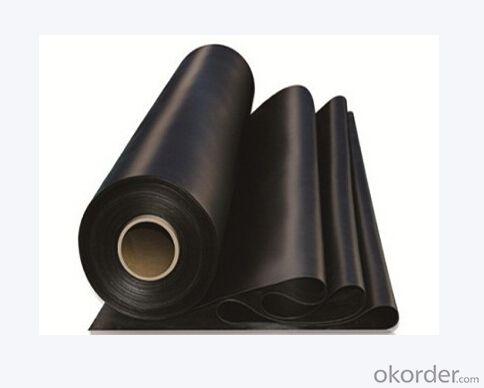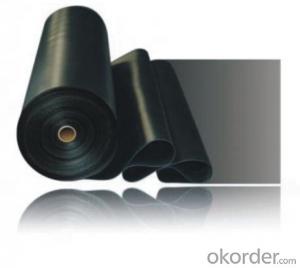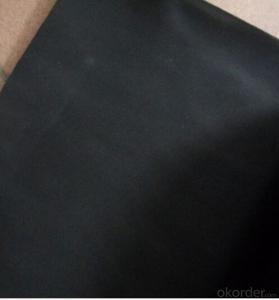Width 2m EPDM Waterproofing Membrane for Pond Use
- Loading Port:
- Qingdao
- Payment Terms:
- TT OR LC
- Min Order Qty:
- 2000 m²
- Supply Capability:
- 100000 m²/month
OKorder Service Pledge
OKorder Financial Service
You Might Also Like
EPDM waterproofing Rubber membrane
1. Product Description of EPDM Waterproofing Membrane:
EPDM Waterproofing Membrane is the modified materials which is widely used at home and abroad in the kinds of roofs, tunnel, basement such sorts of constructions' waterproofing.
They are based upon EPDM rubber with modifier, softener and accelerant assistants added to provide flexibility and stability . Through the precise ingredients, mixing, extrusion, rolling, curing processes to made of modified EPDM Waterproofing material with high strength and high flexibility.
2. Product Features of EPDM Waterproofing Membrane:
1). Great tensile strength,long-range elasticity and aging resistant.
2). Excellent heat reisistant and can be used under -70°C~~+110°C .
3).Good anti-corrosion, ultraviolet resistant, root penetration resistance
4).Long life use over 50 years and used longer 100 years or more under the condition of buried in the ground.
5).Light and easy to install.
3. Product Sepcification of EPDM Waterproofing Membrane:
Thickness : 0.3-2.0mm
Width :1-4m
Length: 15-50m/roll
Item | value | ||
JL1 | JF1 | ||
Tensile Strength (Mpa) | normal tamperature | 7.5 | 4.0 |
60°C ≥ | 2.3 | 0.8 | |
Elongation at break (%) | normal tamperature ≥ | 450 | 450 |
-20°C ≥ | 200 | 200 | |
Tear Resistance (N) | ≥ | 25 | 18 |
Water impermeability | 30mm | 0.3Mpa | 0.3Mpa |
Cold bending | (°C) ≤ | -40 | -30 |
Heating Shrinking rate | extand << span=""> | 2 | 2 |
shrink << span=""> | 4 | 4 | |
4.Product Application of EPDM Waterproofing Membrane:

4. Some photos:


- Q:How does a waterproofing membrane handle movement or settling of a building?
- A waterproofing membrane is designed to accommodate movement or settling of a building in a few different ways. Firstly, it is typically installed in such a way that it can stretch or flex as the building moves. This elasticity allows the membrane to remain intact and continue to provide a watertight seal even as the structure shifts or settles. Additionally, waterproofing membranes often incorporate reinforcement materials, such as fabrics or fibers, which enhance their ability to withstand movement. These reinforcements help distribute the stress or strain caused by building movement across a larger area, reducing the risk of tears or failures in the membrane. Furthermore, some waterproofing membranes are designed with built-in features that can accommodate significant movement. For example, certain membranes may have special "crack-bridging" properties, which allow them to span small cracks that may develop in the building's substrate due to settling. This ensures that the membrane remains effective even if the structure experiences minor damage. In cases where a building is expected to undergo significant movement or settling, specialized waterproofing systems, such as joint sealants or expansion joints, may be used in combination with the membrane. These systems are specifically designed to handle large or dynamic movements, providing additional protection against water infiltration. Overall, a waterproofing membrane is carefully designed and installed to handle the movement or settling of a building. Its elasticity, reinforcement materials, and additional features allow it to remain effective in maintaining a watertight seal, even in the face of structural shifts or settlement.
- Q:Can a waterproofing membrane be used for loading docks?
- Loading docks can benefit greatly from the use of waterproofing membranes. These membranes are commonly employed in various construction applications to safeguard underlying structures against moisture and water damage. Given the high levels of foot and vehicle traffic loading docks experience, along with the potential for water infiltration, installing a waterproofing membrane is highly recommended. By creating a barrier against water intrusion, a waterproofing membrane prevents moisture from seeping into the loading dock area. This is particularly crucial because moisture can compromise the structural integrity of the dock, leading to potential damage and safety hazards. With the installation of a waterproofing membrane, loading docks can be shielded from water-related issues such as corrosion, mold, and deterioration. Moreover, certain waterproofing membranes offer additional advantages beyond water protection. Some have anti-slip properties or resistance to chemicals and oils, which can be advantageous in a loading dock environment. These added features enhance the safety and durability of the loading dock, making it more suitable for heavy loads and frequent use. When selecting a waterproofing membrane for loading docks, it is important to consider the specific requirements and conditions of the dock area. Factors such as the type of traffic, load capacity, and exposure to harsh environments should be evaluated to ensure the chosen membrane is suitable for its intended use. In conclusion, a waterproofing membrane is an effective solution for protecting loading docks against water damage, enhancing safety, and prolonging the lifespan of the structure.
- Q:Are waterproofing membranes suitable for historical buildings?
- Yes, waterproofing membranes can be suitable for historical buildings. These membranes provide an effective solution for preventing water penetration and damage to the structure, helping to preserve the integrity and longevity of the building. However, it is essential to consider the specific requirements and characteristics of the historical building and select an appropriate membrane that is compatible with its materials and architectural features. Additionally, any waterproofing work should be done with sensitivity and care to ensure it does not compromise the historical value or aesthetics of the building.
- Q:Can a waterproofing membrane be used for a hospital basement?
- Yes, a waterproofing membrane can be used for a hospital basement. Waterproofing membranes are commonly used in various construction projects, including hospitals, to prevent water infiltration and protect the structure from moisture-related issues such as leaks, dampness, and mold growth. The basement of a hospital is particularly susceptible to water damage due to its below-grade location, making the use of a waterproofing membrane crucial. The membrane acts as a barrier against water seepage, effectively keeping the basement dry and preventing potential damage to the building and its contents. Additionally, a waterproofing membrane can help maintain a clean and safe environment in the hospital basement by preventing the growth of mold and other harmful microorganisms that thrive in moist conditions. Overall, the use of a waterproofing membrane in a hospital basement is highly recommended to ensure the structural integrity and safety of the building.
- Q:Can a waterproofing membrane be used on precast gypsum surfaces?
- Precast gypsum surfaces, commonly utilized in construction for various building components like walls and ceilings, can benefit from the application of a waterproofing membrane. Without proper protection, these porous surfaces are susceptible to water damage. To safeguard precast gypsum, a waterproofing membrane serves as a barrier, preventing water infiltration. By creating a protective layer, it halts the seepage of water into the gypsum, thereby averting issues such as mold growth and deterioration. Multiple types of waterproofing membranes are available in the market, including liquid-applied membranes, sheet membranes, and cementitious coatings. These versatile options can adhere effectively to precast gypsum and other surface materials. When employing a waterproofing membrane on precast gypsum, it is vital to ensure the surface is devoid of any contaminants that could hinder the membrane's adhesion. The application process should adhere to the manufacturer's instructions, taking into account factors like temperature, humidity, and drying time. In summary, the application of a waterproofing membrane on precast gypsum surfaces is indeed possible and highly recommended for protection against water damage. Selecting the appropriate membrane type and following proper application techniques are crucial for optimal efficacy.
- Q:How does a waterproofing membrane handle freeze-thaw cycles?
- A waterproofing membrane is designed to handle freeze-thaw cycles by being flexible and resistant to cracking. It should be able to expand and contract with temperature fluctuations without compromising its waterproofing properties. Additionally, it should have good adhesion to the substrate to prevent water infiltration and damage during these cycles.
- Q:How thick should a waterproofing membrane be applied?
- The application of a waterproofing membrane is dependent on several factors, including the type of membrane, its intended use, and the project's specific requirements. Typically, the thickness of a waterproofing membrane can vary between 1 and 2 millimeters. When using liquid-applied membranes, it is advisable to apply multiple coats in order to achieve the desired thickness. The number of coats and the thickness per coat will be determined by the manufacturer's instructions and the specific needs of the application. For sheet membranes, the thickness is generally predetermined by the manufacturer and is available in various options, ranging from 0.5 to 2 millimeters. The selection of the appropriate thickness should be based on the project's specific needs, taking into account factors such as the condition of the substrate, expected movement, and required level of protection. In certain instances, local building codes and regulations may also dictate the thickness of the waterproofing membrane. To determine the suitable thickness for a particular application, it is important to consult with a professional waterproofing contractor or refer to the guidelines provided by the manufacturer.
- Q:Does a waterproofing membrane have any impact on the indoor air quality?
- The impact of a waterproofing membrane on indoor air quality should not be underestimated. Waterproofing membranes, commonly used to prevent water infiltration in moisture-prone areas like basements, roofs, and foundations, are typically made of synthetic materials like polyethylene or polypropylene. Unfortunately, these materials can release volatile organic compounds (VOCs) into the air. VOCs are chemicals that can evaporate at room temperature and have negative effects on indoor air quality. They contribute to the formation of indoor air pollutants, including formaldehyde and benzene. Prolonged exposure to VOCs can result in health issues such as eye, nose, and throat irritation, headaches, dizziness, and respiratory problems. However, it's important to note that not all waterproofing membranes have the same impact on indoor air quality. Some manufacturers have developed low VOC or VOC-free membranes that aim to minimize the release of harmful chemicals. These products undergo rigorous testing to meet stringent air quality standards. In addition, proper installation and ventilation are crucial in mitigating any potential negative impact on indoor air quality. Adequate ventilation systems help eliminate VOCs and other pollutants, preventing them from accumulating and causing health problems. Therefore, when considering the installation of a waterproofing membrane, it's crucial to select a product that has been tested for low VOC emissions and ensure proper ventilation is in place to maintain good indoor air quality. Seeking guidance from professionals in the field can assist in choosing the most suitable waterproofing solution for specific needs while minimizing any potential impact on indoor air quality.
- Q:The shortcomings of polypropylene waterproofing, and the shortcomings of modified asphalt waterproofing membrane
- but the current domestic Still less match with the binder, because the environment and bonding materials and other factors often lose their bond function in advance, resulting in water failure will be self-evident; then waterproofing membrane after the construction of the protection And the leak after the maintenance is also a problem, exposed to the outside of the waterproof layer of foreign mechanical damage prevention is very important, waterproof membrane and grass-roots bonding, whether it is full shop, shop, shop, empty shop, The grassroots will be between the water layer, regardless of any part of the penetrating breakage, degumming, leakage of glue (even if there is only one), the entire level of its connection with the waterproof function will all decline, if not Find damaged and defective parts, the local repair is not possible, then only redo waterproof layer. So it is better to waterproof polypropylene
- Q:Can a waterproofing membrane be used for museums or art galleries?
- Yes, a waterproofing membrane can be used for museums or art galleries. Waterproofing membranes are commonly used in various industries, including construction, to protect buildings from water damage. In the case of museums or art galleries, where valuable artifacts or artwork are housed, it is crucial to maintain a controlled environment to prevent any water-related issues such as leaks, moisture, or humidity. A waterproofing membrane can be applied to the walls, floors, or even roofs of these establishments to create a barrier against water intrusion. It helps in preventing water from seeping through the building structure, protecting the artwork from potential damage. Additionally, a waterproofing membrane can also aid in controlling the humidity levels within the museum or art gallery. By reducing moisture penetration, it helps maintain a stable environment, crucial for preserving delicate artwork or artifacts that are sensitive to humidity fluctuations. Moreover, waterproofing membranes come in various types, allowing for customization based on the specific requirements of the museum or art gallery. Some membranes are designed to withstand high water pressure, making them suitable for areas prone to heavy rainfall or potential flooding. Ultimately, using a waterproofing membrane in museums or art galleries is an effective measure to safeguard the valuable contents of these establishments, preserving them for future generations to enjoy.
1. Manufacturer Overview |
|
|---|---|
| Location | |
| Year Established | |
| Annual Output Value | |
| Main Markets | |
| Company Certifications | |
2. Manufacturer Certificates |
|
|---|---|
| a) Certification Name | |
| Range | |
| Reference | |
| Validity Period | |
3. Manufacturer Capability |
|
|---|---|
| a)Trade Capacity | |
| Nearest Port | |
| Export Percentage | |
| No.of Employees in Trade Department | |
| Language Spoken: | |
| b)Factory Information | |
| Factory Size: | |
| No. of Production Lines | |
| Contract Manufacturing | |
| Product Price Range | |
Send your message to us
Width 2m EPDM Waterproofing Membrane for Pond Use
- Loading Port:
- Qingdao
- Payment Terms:
- TT OR LC
- Min Order Qty:
- 2000 m²
- Supply Capability:
- 100000 m²/month
OKorder Service Pledge
OKorder Financial Service
Similar products
New products
Hot products
Related keywords





























